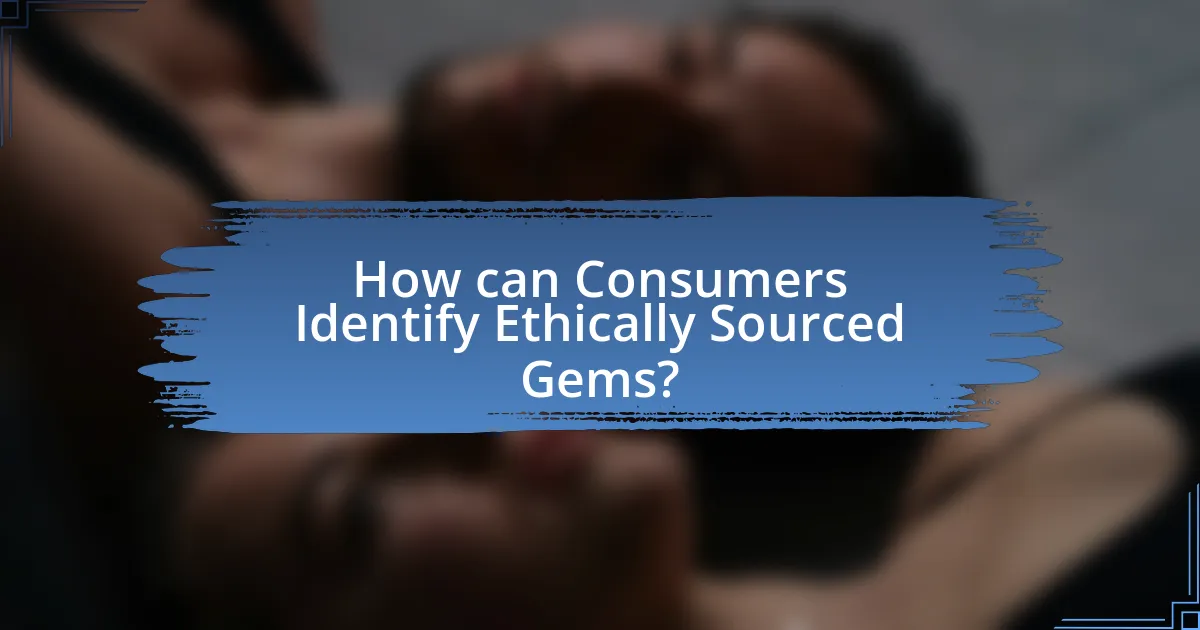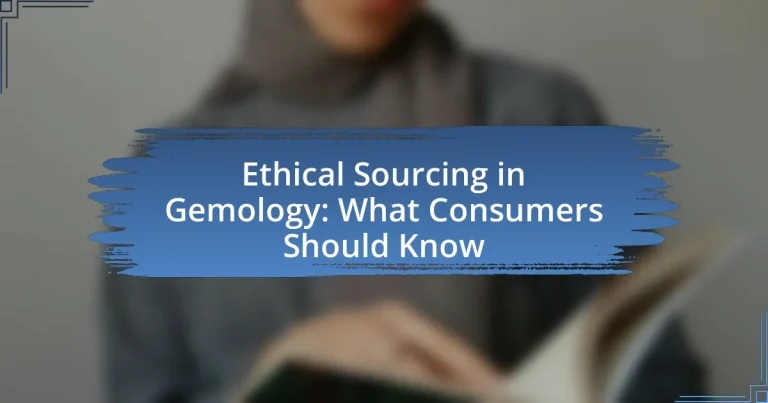Ethical sourcing in gemology is the practice of obtaining gemstones in a socially responsible and environmentally sustainable manner, ensuring that their extraction does not contribute to human rights abuses or environmental degradation. This article outlines the significance of ethical sourcing, including its impact on local communities, the principles that guide it, and the role of certifications in verifying ethical practices. It also addresses the challenges faced in enforcing ethical standards and provides practical tips for consumers to identify and support ethically sourced gems. By prioritizing transparency and accountability, consumers can influence the gem industry towards more responsible practices.

What is Ethical Sourcing in Gemology?
Ethical sourcing in gemology refers to the practice of obtaining gemstones in a manner that is socially responsible and environmentally sustainable. This approach ensures that the extraction and trade of gems do not contribute to human rights abuses, environmental degradation, or conflict financing. For instance, the Kimberley Process Certification Scheme was established to prevent the trade of conflict diamonds, highlighting the importance of traceability and ethical standards in the gem industry.
Why is Ethical Sourcing Important in Gemology?
Ethical sourcing is important in gemology because it ensures that gemstones are obtained in a manner that respects human rights, environmental sustainability, and fair labor practices. The gem industry has historically been associated with issues such as conflict diamonds, which fund violence and human rights abuses, and exploitative labor conditions in mining operations. By prioritizing ethical sourcing, consumers can support practices that promote transparency, accountability, and social responsibility within the industry. For instance, the Kimberley Process was established to prevent the trade of conflict diamonds, highlighting the industry’s commitment to ethical standards.
What are the ethical implications of gem mining?
The ethical implications of gem mining include environmental degradation, human rights abuses, and economic inequality. Gem mining often leads to deforestation, soil erosion, and water pollution, which disrupt local ecosystems. Additionally, many mining operations exploit workers, subjecting them to unsafe conditions and inadequate wages. According to a report by the World Bank, approximately 20% of artisanal miners work in hazardous conditions, highlighting the urgent need for ethical practices. Furthermore, the profits from gem mining frequently do not benefit local communities, exacerbating economic disparities. These factors underscore the importance of ethical sourcing in gemology, as consumers increasingly demand transparency and responsibility in the supply chain.
How does ethical sourcing impact local communities?
Ethical sourcing positively impacts local communities by promoting fair labor practices and sustainable economic development. When companies prioritize ethical sourcing, they often ensure that workers receive fair wages and safe working conditions, which can lead to improved quality of life for community members. For instance, a study by the Ethical Trading Initiative found that ethical sourcing practices can increase household incomes by up to 30% in some regions. Additionally, ethical sourcing can foster community investment, as businesses may contribute to local infrastructure and education initiatives, further enhancing community well-being.
What are the key principles of Ethical Sourcing?
The key principles of Ethical Sourcing include transparency, fair labor practices, environmental sustainability, and community engagement. Transparency ensures that the supply chain is clear and traceable, allowing consumers to understand the origins of the products they purchase. Fair labor practices involve providing safe working conditions and fair wages to workers involved in the sourcing process. Environmental sustainability focuses on minimizing ecological impact through responsible extraction and production methods. Community engagement emphasizes the importance of supporting local communities and ensuring that they benefit from the resources extracted from their land. These principles are essential for promoting ethical practices in gemology and ensuring that consumers can make informed choices.
What does traceability mean in the context of gemology?
Traceability in gemology refers to the ability to track the origin and journey of a gemstone from its source to the final consumer. This process ensures that the gemstone is ethically sourced, providing transparency regarding its mining conditions, labor practices, and environmental impact. For instance, traceability systems often involve documentation and certification that verify the gemstone’s provenance, helping to prevent the trade of conflict diamonds and promoting responsible mining practices.
How do certifications play a role in ethical sourcing?
Certifications play a crucial role in ethical sourcing by providing verified assurance that products meet specific ethical standards. These certifications, such as the Kimberley Process for diamonds or Fair Trade certification for gemstones, ensure that sourced materials are obtained without contributing to human rights abuses, environmental degradation, or conflict financing. For instance, the Kimberley Process has been instrumental in reducing the trade of conflict diamonds, as it requires participating countries to certify that diamonds are conflict-free. This verification process enhances consumer trust and promotes responsible sourcing practices within the gemology industry.

How can Consumers Identify Ethically Sourced Gems?
Consumers can identify ethically sourced gems by seeking certifications from reputable organizations that verify ethical practices, such as the Responsible Jewellery Council or the Kimberley Process. These certifications ensure that gems are sourced without contributing to human rights abuses or environmental degradation. Additionally, consumers should inquire about the supply chain transparency from retailers, as ethical gem suppliers often provide detailed information about the origin and mining practices of their stones. Research indicates that approximately 70% of consumers prefer to buy products that are ethically sourced, highlighting the growing demand for transparency in the gem industry.
What questions should consumers ask when purchasing gems?
Consumers should ask about the origin of the gems to ensure they are ethically sourced. Questions should include: “Where was this gem mined?” to verify its source, “What are the labor practices involved in its extraction?” to assess ethical labor conditions, and “Is there a certification or documentation proving ethical sourcing?” to confirm authenticity. Additionally, consumers should inquire about the environmental impact of the mining process, asking “What measures are taken to minimize environmental damage?” This approach helps consumers make informed decisions aligned with ethical standards in gemology.
How can consumers verify the source of their gems?
Consumers can verify the source of their gems by requesting a gemological certificate from a reputable laboratory. This certificate provides detailed information about the gem’s origin, including its geographical source and any treatments it may have undergone. For instance, organizations like the Gemological Institute of America (GIA) and the International Gemological Institute (IGI) offer certification services that are widely recognized in the industry. These certificates are based on rigorous testing and analysis, ensuring that consumers receive accurate information about their gems.
What role do gem retailers play in ethical sourcing?
Gem retailers play a crucial role in ethical sourcing by ensuring that the gemstones they sell are obtained through responsible and sustainable practices. They are responsible for verifying the supply chain, which includes assessing the origins of the gems and ensuring that they are not sourced from conflict zones or exploitative labor conditions. Retailers often collaborate with suppliers who adhere to ethical standards, such as the Kimberley Process for diamonds, which aims to prevent the trade of conflict diamonds. Additionally, many retailers provide transparency to consumers by offering information about the sourcing of their gems, thus promoting informed purchasing decisions. This commitment to ethical sourcing not only supports fair labor practices but also contributes to environmental sustainability in gem mining.
What are the signs of ethically sourced gems?
Signs of ethically sourced gems include certification from recognized organizations, transparency in the supply chain, and adherence to fair labor practices. Certifications such as those from the Responsible Jewellery Council or Fair Trade ensure that gems are mined and traded under ethical conditions. Transparency in the supply chain allows consumers to trace the origin of the gems, confirming they are sourced from conflict-free zones. Additionally, ethical sourcing involves fair wages and safe working conditions for miners, which can often be verified through independent audits and reports.
How can consumers recognize reputable certifications?
Consumers can recognize reputable certifications by verifying the issuing organization’s credibility and standards. Reputable certifications are typically issued by recognized industry bodies that adhere to established guidelines, such as the Gemological Institute of America (GIA) or the International Gemological Institute (IGI). These organizations employ trained gemologists who follow rigorous grading systems and ethical sourcing practices. Additionally, consumers should look for transparency in the certification process, including detailed reports that outline the criteria used for evaluation. Certifications that include specific information about the gem’s origin and treatment history further enhance their reliability.
What documentation should accompany ethically sourced gems?
Ethically sourced gems should be accompanied by a certificate of authenticity, which verifies the gem’s origin and ethical sourcing practices. This documentation typically includes details such as the mine of origin, the methods used in extraction, and confirmation that no child labor or conflict financing was involved. Additionally, a provenance report may be provided, outlining the gem’s journey from mine to market, ensuring transparency in the supply chain. Such documentation is crucial as it helps consumers make informed choices and supports ethical practices in the gem industry.

What Challenges Exist in Ethical Sourcing of Gems?
The challenges in ethical sourcing of gems include lack of transparency, human rights abuses, and environmental degradation. Lack of transparency arises because many gem supply chains are complex and opaque, making it difficult for consumers to trace the origins of gems. Human rights abuses, such as child labor and unsafe working conditions, are prevalent in regions where gems are mined, particularly in developing countries. Environmental degradation occurs due to mining practices that can lead to habitat destruction and pollution. According to a report by the Responsible Jewelry Council, approximately 20% of the world’s gemstones are sourced ethically, highlighting the significant gap in responsible sourcing practices.
What are the common obstacles to ethical sourcing in gemology?
Common obstacles to ethical sourcing in gemology include lack of transparency in supply chains, inadequate regulatory frameworks, and the prevalence of conflict minerals. Transparency issues arise when gem suppliers do not disclose the origins of their stones, making it difficult for consumers to verify ethical practices. Regulatory frameworks often fail to enforce strict guidelines for ethical sourcing, allowing unethical practices to persist. Additionally, conflict minerals, which are sourced from regions experiencing violence and human rights abuses, complicate the sourcing process, as these gems may enter the market without proper oversight. According to a report by the United Nations, the diamond trade has been linked to funding armed conflict, highlighting the urgent need for improved ethical sourcing practices in the industry.
How do economic factors influence ethical sourcing practices?
Economic factors significantly influence ethical sourcing practices by determining the cost structures and profitability of sourcing decisions. For instance, companies often weigh the financial implications of sourcing materials ethically against cheaper, less ethical alternatives. A study by the Ethical Trading Initiative found that businesses that invest in ethical sourcing can enhance their brand reputation and customer loyalty, which can lead to increased sales and market share. Additionally, fluctuations in commodity prices can compel companies to reassess their sourcing strategies, as higher costs may push them towards more sustainable practices to mitigate risks associated with supply chain disruptions.
What are the challenges in enforcing ethical standards?
Enforcing ethical standards in gemology faces significant challenges, primarily due to the lack of transparency in supply chains. Many gemstones are sourced from regions with minimal regulation, making it difficult to trace their origins and ensure compliance with ethical practices. Additionally, the high value of gemstones can incentivize unethical behavior, such as bribery and corruption, which undermines enforcement efforts. According to a report by the World Bank, approximately 80% of the world’s gemstones are unregulated, highlighting the scale of the issue. Furthermore, varying cultural perceptions of ethics across different regions complicate the establishment of universal standards, leading to inconsistent enforcement.
How can consumers advocate for ethical sourcing?
Consumers can advocate for ethical sourcing by actively choosing to purchase products from companies that demonstrate transparency in their supply chains and adhere to ethical sourcing practices. This includes researching brands that provide certifications or third-party audits verifying their commitment to ethical labor practices and environmental sustainability. For instance, organizations like the Responsible Jewelry Council and Fair Trade certify companies that meet specific ethical standards, ensuring that consumers can make informed choices. By supporting these brands, consumers not only promote ethical sourcing but also encourage other companies to adopt similar practices, thereby influencing the market towards greater accountability and responsibility in gemology.
What actions can consumers take to support ethical gem sourcing?
Consumers can support ethical gem sourcing by choosing to purchase gems from certified ethical sources. This includes seeking out retailers who provide transparency about their supply chains and adhere to recognized ethical standards, such as the Responsible Jewellery Council or the Kimberley Process. Research indicates that ethical sourcing practices can significantly reduce the negative social and environmental impacts associated with gem mining, as these certifications often require adherence to labor rights and environmental protection standards. By prioritizing purchases from these certified sources, consumers can contribute to a market that values ethical practices and encourages responsible mining operations.
How can consumer awareness drive change in the gem industry?
Consumer awareness can drive change in the gem industry by increasing demand for ethically sourced gemstones. When consumers prioritize transparency and ethical practices, gem retailers are compelled to adopt responsible sourcing methods to meet this demand. For instance, a 2021 survey by the Ethical Consumer Research Association found that 70% of consumers are willing to pay more for ethically sourced products, indicating a significant market shift towards sustainability. This heightened awareness encourages companies to implement traceability systems and adhere to ethical standards, ultimately leading to improved labor practices and environmental sustainability in gem mining.
What practical tips can consumers follow for ethical gem purchases?
Consumers can follow several practical tips for ethical gem purchases, including researching the source of the gems, asking for certifications, and supporting companies with transparent supply chains. Researching the source allows consumers to identify whether gems are mined responsibly and ethically, as many regions have regulations to prevent exploitation. Certifications from organizations like the Responsible Jewellery Council or Fair Trade can provide assurance that gems meet ethical standards. Additionally, supporting companies that disclose their sourcing practices and engage in fair labor practices ensures that purchases contribute positively to communities involved in gem mining. These practices help consumers make informed decisions that align with ethical considerations in gemology.


